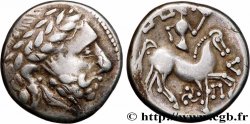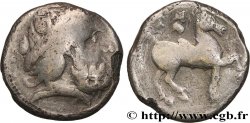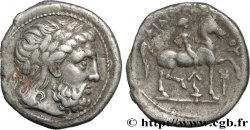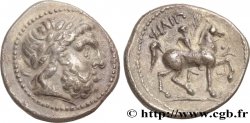v61_0400 - DANUBIAN CELTS - IMITATIONS OF THE TETRADRACHMS OF PHILIP II AND HIS SUCCESSORS Tétradrachme au cavalier et au bandeau perlé, imitation de Philippe II
MONNAIES 61 (2014)
Starting price : 400.00 €
Estimate : 600.00 €
unsold lot
Starting price : 400.00 €
Estimate : 600.00 €
unsold lot
Type : Tétradrachme au cavalier et au bandeau perlé, imitation de Philippe II
Date: (IIe-Ier siècles avant J.-C.)
Metal : silver
Diameter : 24,5 mm
Orientation dies : 7 h.
Weight : 13,35 g.
Rarity : R2
Coments on the condition:
Très bel exemplaire d’un style inhabituel. Les types sont complets mais avec une certaine usure, surtout au droit. Patine grise de collection ancienne
Obverse
Obverse legend : ANÉPIGRAPHE.
Obverse description : Tête laurée de Zeus à droite ; grènetis.
Reverse
Reverse description : Cavalier au pas à droite, les cheveux hirsutes ; un annelet devant le cheval.
Commentary
Si le statère d’or de Philippe II de Macédoine a servi de prototype à de nombreuses imitations gauloises, le tétradrachme n’a pas été imité en Gaule, mais reste principal sujet d’inspiration des monnaies pour les Celtes du Danube (LT. 9697-9767, 9768-9832, 9618-9630, 9870-9886).
Cet exemplaire est intéressant, avec une tête laurée au droit, mais les lauriers sont constitués de trois lignes de globules. Le revers est pus habituel, mais pas associé à cet avers !
La monnaie n° 1043 du musée de Vienne y correspond exactement, avec une probable liaison de coin de droit, mais pas de revers.
Cet exemplaire est intéressant, avec une tête laurée au droit, mais les lauriers sont constitués de trois lignes de globules. Le revers est pus habituel, mais pas associé à cet avers !
La monnaie n° 1043 du musée de Vienne y correspond exactement, avec une probable liaison de coin de droit, mais pas de revers.








 Report a mistake
Report a mistake Print the page
Print the page Share my selection
Share my selection Ask a question
Ask a question Consign / sell
Consign / sell
 Full data
Full data









